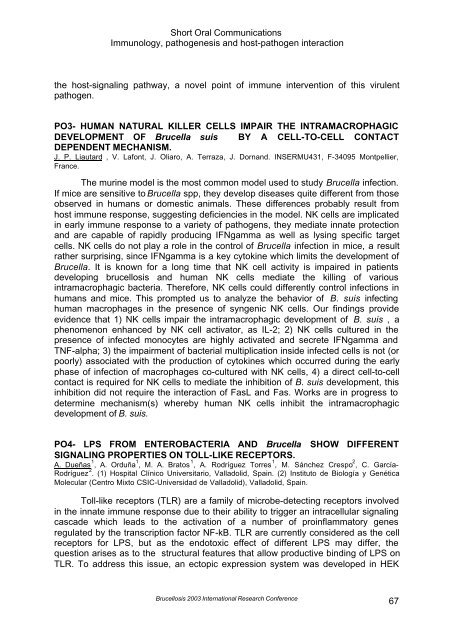Brucellosis 2003 proceedings - PHIDIAS
Brucellosis 2003 proceedings - PHIDIAS
Brucellosis 2003 proceedings - PHIDIAS
You also want an ePaper? Increase the reach of your titles
YUMPU automatically turns print PDFs into web optimized ePapers that Google loves.
Short Oral Communications<br />
Immunology, pathogenesis and host-pathogen interaction<br />
the host-signaling pathway, a novel point of immune intervention of this virulent<br />
pathogen.<br />
PO3- HUMAN NATURAL KILLER CELLS IMPAIR THE INTRAMACROPHAGIC<br />
DEVELOPMENT OF Brucella suis BY A CELL-TO-CELL CONTACT<br />
DEPENDENT MECHANISM.<br />
J. P. Liautard , V. Lafont, J. Oliaro, A. Terraza, J. Dornand. INSERMU431, F-34095 Montpellier,<br />
France.<br />
The murine model is the most common model used to study Brucella infection.<br />
If mice are sensitive to Brucella spp, they develop diseases quite different from those<br />
observed in humans or domestic animals. These differences probably result from<br />
host immune response, suggesting deficiencies in the model. NK cells are implicated<br />
in early immune response to a variety of pathogens, they mediate innate protection<br />
and are capable of rapidly producing IFNgamma as well as lysing specific target<br />
cells. NK cells do not play a role in the control of Brucella infection in mice, a result<br />
rather surprising, since IFNgamma is a key cytokine which limits the development of<br />
Brucella. It is known for a long time that NK cell activity is impaired in patients<br />
developing brucellosis and human NK cells mediate the killing of various<br />
intramacrophagic bacteria. Therefore, NK cells could differently control infections in<br />
humans and mice. This prompted us to analyze the behavior of B. suis infecting<br />
human macrophages in the presence of syngenic NK cells. Our findings provide<br />
evidence that 1) NK cells impair the intramacrophagic development of B. suis , a<br />
phenomenon enhanced by NK cell activator, as IL-2; 2) NK cells cultured in the<br />
presence of infected monocytes are highly activated and secrete IFNgamma and<br />
TNF-alpha; 3) the impairment of bacterial multiplication inside infected cells is not (or<br />
poorly) associated with the production of cytokines which occurred during the early<br />
phase of infection of macrophages co-cultured with NK cells, 4) a direct cell-to-cell<br />
contact is required for NK cells to mediate the inhibition of B. suis development, this<br />
inhibition did not require the interaction of FasL and Fas. Works are in progress to<br />
determine mechanism(s) whereby human NK cells inhibit the intramacrophagic<br />
development of B. suis.<br />
PO4- LPS FROM ENTEROBACTERIA AND Brucella SHOW DIFFERENT<br />
SIGNALING PROPERTIES ON TOLL-LIKE RECEPTORS.<br />
A. Dueñas 1 , A. Orduña 1 , M. A. Bratos 1 , A. Rodríguez Torres 1 , M. Sánchez Crespo 2 , C. García-<br />
Rodríguez 2 . (1) Hospital Clínico Universitario, Valladolid, Spain. (2) Instituto de Biología y Genética<br />
Molecular (Centro Mixto CSIC-Universidad de Valladolid), Valladolid, Spain.<br />
Toll-like receptors (TLR) are a family of microbe-detecting receptors involved<br />
in the innate immune response due to their ability to trigger an intracellular signaling<br />
cascade which leads to the activation of a number of proinflammatory genes<br />
regulated by the transcription factor NF-kB. TLR are currently considered as the cell<br />
receptors for LPS, but as the endotoxic effect of different LPS may differ, the<br />
question arises as to the structural features that allow productive binding of LPS on<br />
TLR. To address this issue, an ectopic expression system was developed in HEK<br />
<strong>Brucellosis</strong> <strong>2003</strong> International Research Conference<br />
67
















